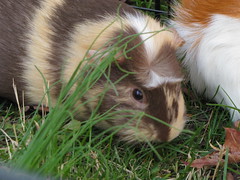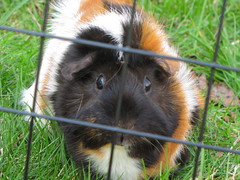
Hello all, I'm back from the North Country! And man, I had such a blast and learned SO much. If you want to see photos from the trip, they are here on my Flickr page.
So this episode of Cutting Back is all about veggies. And I'll be honest, a lot of this is common sense stuff that many of us don't really think about. I've been back from the North Country for a week and a half now, and I've been working on this post for a while trying to compile all of the little stuff.
It seems obvious, but that isn't alway the case..
Know your veggies. It is definitely important to know your veggies. Too much of something, like spinach, kale or silverbeet [swiss chard] can be bad for guinea pigs. If you don't memorize well, I recommend you print out Ly's Nutrition Charts from Guineapigcages.com and keep them in your purse/wallet or bring them to the grocery store. In a nutshell, your pig's menu should be lettuce-based, with a good variety of leafy greens each week. My guinea pigs usually get 1-2 kinds of lettuce, one dark leafy green and one or two kinds of herbs each week. I know my veggies very well because I have been doing this for a long time. Practice makes perfect.
Stick to your budget! I spend between $19-$21 each week on greens for my 7 cavies and two rabbits. More than that, and I know I've simply bought too much. Less, and I know I'll be back to the grocery store later in the week. Make a budget, and stick to it. This goes a long way with helping you to cut back on your expenses.

Prep your veggies ahead of time. Many of you are familiar with my post on prepping salads. If you need to cut down on the time that that prep takes, you can cut out the washing/spinning step, which takes the longest and can be done at the time that the salad is served. I do this when I have a busy weekend and don't have two hours to devote to making 10 boxes of salads.
Prepping your salads in advance allows you to portion out your greens so that you're giving your pigs the amount that they need, and you're not using too much and running out early, messing up both your budget and your weekly routine.
Grow your own. I'm not suggesting you go all-out and flood your balcony with 21 heads of lettuce, 3 tomato plants, 2 bell pepper vines and a 2 window boxes full of spinach. Though it you want to, by all means. The more you grow, the more you'll save. I grow about 1/3 of the greens that my cavies eat in the summer time. If you have space on your steps, your porch, your balcony or, if you're lucky enough, some backyard, I encourage you to get your hands dirty and grow some food for your pigs.
Get it locally/in bulk. Things like carrot and celery greens are something that most farmers remove before selling their product. Contact a local farmer and ask them for these perfectly nutritious, delicious greens. I also recommend shopping at the farmer's market when greens are in season. The prices there are much better and the money you spend goes back into your community.
If you have a lot a lot a lot of green-munchers, you can buy a box [about 20-25lbs] of greens from the grocery store for around $20. I know many fosterers who do this. Just be sure you can keep the greens cool. They won't last longer than 7-10 days at the very most.

Storing veggies
I have a lot of green-munching mammals in the house, and I am lucky enough to have two refrigerators. But it has not always been this way. There are many ways to store your veggies.
Coolers. While I was boarding my animals over this past summer/fall, I kept a large cooler in their room so that I could keep their food as close to them as possible. The downside was that, especially in the summer, I had to change the ice at least once a day.
An old chest freezer/fridge. I am a big fan of repurposing old chest freezers and refrigerators. These are very hard to 'recycle' and often they're doomed to hundreds of years in a landfill until Wall-E discovers a plant in a shoe inside one of them. You can use them just like coolers, except you have much more room! If you buy your greens in bulk this is the way to go.
Your ventilator drawer. If your house isn't overflowing with guinea pigs, you can just use the ventilator drawer of your fridge. Really, anywhere that is between 40-55F will do. Many people just keep greens in their basement.

I'm searching for the "thank you for this useful post" button from GPC forum!
ReplyDeleteThanks for all that awesome info. I'll definitely be using your tips.
Considering adopting a pair of males . . . so that would double my herd. Will be using your "cutting back" posts a lot in the future!
Thanks again.